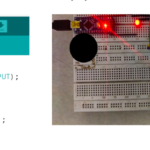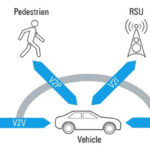When designing an embedded system with an MCU, which one should you pick? This guide provides you with a quick overview to help you narrow down your choices.
A microcontroller (MCU), is the smallest and most basic computer. Running on a single chip, it has a CPU, memories (RAM and ROM), and interfaces (input/output ports) for additions like video, audio, USB, and cameras. Unlike a microprocessor, which serves more generalized applications, a microcontroller aims at more specific applications.
A microcontroller has many uses: in consumer electronics like toys and appliances, in communication devices like cell phones and computers, and in medical instruments like ECG machines and monitors. Also, in industrial settings, it can be used to control temperature or pressure, count time, measure speed, or activate the braking system. Because microcontrollers are suitable for specific tasks, it is essential to choose a microcontroller that is most appropriate for a project. There are many factors to consider.
Power efficiency. There is a trade-off between processing performance and power consumption: a device with higher processing power will consume more energy. Therefore, if your microcontroller is wireless and running on a rechargeable battery, you need to weigh sacrificing power efficiency against getting more processing power, or vice versa. Some power-efficient microcontrollers include STMicroelectronics’ STM32 series, NXP’s Kinetis L series, Renesas’ H8 Super Low Power series, Cypress’ PSoC 6 series, Microchip’s eXtreme Low Power PIC series, and Texas Instruments’ MSP430 series.
Temperature tolerance. Depending on the environment in which your microcontrollers operate, you may want devices that withstand extreme temperature. There will be a trade-off between temperature tolerance and cost. Some temperature-tolerant microcontrollers include STMicroelectronics’ STM32F103 series, NXP’s Kinetis EA series, Renesas’ RX24T and RX24U, Infineon’s XMC series and AURIX™ series, Microchip’s: PIC and AVR microcontrollers, and Texas Instruments’ MSP430F2619S-HT.
Security. Hacking which targets IoT devices is rising, a threat that is especially relevant to microcontrollers used in automobiles. In response, microcontroller makers are implementing layers of security such as cryptography and physical security. Now, users can purchase microcontrollers that have been certified to the latest security standards or use MCUs with on-chip secure hardware. Companies that offer stand-alone security MCUs include STMicroelectronics (ST33 series), Renesas (AE-5 and RS-4 series), Infineon (OPTIGA Trust and OPTIGA TPM), Cypress (PSoC 64), Microchip (32-bit and 16-bit MCUs for Security), and Texas Instruments (MSP430 series). Companies that offer on-chip security hardware include NXP (Kinetis series) and Infineon (AURIX).
Hardware architecture. A microcontroller’s packaging directly influences its size and performance. Dual in-line packaging is the most common type. Small-outline transistors have a small footprint, and quad flat packs take up more areas but less vertical space. Wafer level chip-scales are much smaller and pack in more processing power but are more expensive to manufacture. Flat no-lead packages are better in heat diffusion. Ball grid arrays (BGAs) have high performance due to the compact package but also cost more to fabricate.
Some of the smallest footprint microcontrollers include Microchip’s (formerly Atmel’s) ATtiny20-UUR, Cypress’ PSoC 4000, NXP’s LPC1102UK, STMicroelectronics’ STM32F042T6Y6, and Texas Instrument’s MSP430G2252.
Processing power. How much processing power do you require for the task, will a single core processor suffice, or do you need a dual-core? A multicore processor will be significantly faster, but it will also consume more energy. Also, will a graphics processing unit (GPU) be necessary?
Memory. The amount of memory (RAM and ROM) you need will depend on the programs you will be running. More programs need more random access memory (RAM). In addition, a GPU will require not only more RAM but faster read/write time as well.
Hardware interface. The nature of the task will dictate the need for hardware interfaces such as USB, Wi-Fi, Bluetooth, audio, video, or camera.
Software architecture. Some microcontrollers are operable on multiple OSs, and others are not. If you need to scale, it is better to use the same software architecture to increase interoperability.
Cost. Microcontrollers fall within a wide price range, from a hundred units for a few dollars to a few dollars per unit. If you want to scale, you need to consider the overall cost versus the individual performance power of a microcontroller.
Here are examples of specialty microcontrollers from different manufacturers:
| Company | Power Efficiency | Temperature Tolerance | Security | Small Size |
| STMicroelectronics | STM32 series | STM32F103 series | ST33 MCUs | STM32F042T6Y6 |
| NXP | Kinetis L series | Kinetis EA series | Kinetis | LPC1102UK |
| Renesas | H8 Super Low Power series | RX24T and RX24U | AE-5 and RS-4 | |
| Infineon | XMC series and AURIX series | OPTIGA™ Trust, OPTIGA™ TPM, and AURIX™ | ||
| Cypress | PSoC 6® series | PSoC® 64 | PSoC 4000 | |
| Microchip | eXtreme Low Power PIC® series | PIC® and AVR® | 32-bit and 16-bit MCUs | ATTiny20-UUR |
| Texas Instruments | MSP430 series | MSP430F2619S-HT | MSP430 MCUs | MSP430G2252 |







Leave a Reply
You must be logged in to post a comment.